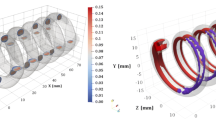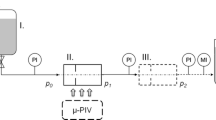Abstract
The flow in a high aspect ratio generic cooling duct is described for different Reynolds numbers and for adiabatic as well as non-adiabatic conditions. The Reynolds number is varied in a range from 39,000 to 111,000. The generic cooling duct facility allows for applying a constant temperature on the duct’s lower wall, and it ensures having well-defined boundary conditions. The high-quality, optical noninvasive measurement methods, namely Particle Image Velocimetry (2C2D-PIV, i.e., two velocity components in a plane), Stereo Particle Image Velocimetry (3C2D-PIV, i.e., three velocity components in a plane) and Volumetric Particle Tracking Velocimetry (3C3D-PTV, i.e., three velocity components in a volume), are used to characterize the flow in detail. Pressure transducers are installed for measuring the pressure losses. The repeatability and the validity of the data are discussed in detail. For that purpose, modifications in the test facility and in the experimental setup as well as comparisons between the different measurement methods are given. A focus lies on the average velocity distribution and on the turbulent statistics. The longitudinal velocity profile is analyzed in detail for Reynolds number variations. Secondary flows are identified with velocities of two orders of magnitude smaller than the longitudinal velocity. Reynolds stress distributions are given for several different cases. The Reynolds number dependency of \(\overline{u'^2}\) and \(\overline{v'^2}\) is shown, and a comparison between the adiabatic and the heated case is given. \(\overline{u'^2}\) changes significantly when the lower wall heat flux is applied, whereas \(\overline{v'^2}\) and \(\overline{u'v'}\) almost stay constant.


















Similar content being viewed by others
References
Bergman TL, Lavine AS, Incropera FP, De Witt DP (2011) Fundamentals of heat and mass transfer, 7th edn. Wiley, Hoboken
Brundrett E, Baines WD (1964) The production and diffusion of vorticity in duct flow. J Fluid Mech 19:375–394
Choi HS, Park TS (2013) The influence of streamwise vortices on turbulent heat transfer in rectangular ducts with various aspect ratios. Int J Heat Fluid Flow 40:1–14
Fuchs T, Heinold M, Hain R, Kähler CJ (2014) Stereoscopic astigmatism particle tracking velocimetry for macroscopic 3D3C flow measurements in air. In: Proceedings of the 17th International symposium on applications of laser techniques to fluid mechanics lisbon, Portugal
Gessner FB, Jones JB (1965) On some aspects of fully-developed turbulent flow in rectangular channels. J Fluid Mech 23:689–713
Hussain AKMF, Reynolds WC (1975) Measurements in fully developed turbulent channel flow. J Fluids Eng 97:568–578
Kwon YS, Philip J, de Silva CM, Hutchins N, Monty JP (2014) The quiescent core of turbulent channel flow. J Fluid Mech 751:228–254
Launder BE, Ying WM (1972) Secondary flows in ducts of square cross-section. J Fluid Mech 54:289–295
Maas HG, Gruen A, Papantoniou D (1993) Particle tracking velocimetry in three-dimensional flows. Exp Fluids 15:133–147
Melling A, Whitelaw JH (1976) Turbulent flow in a rectangular duct. J Fluid Mech 78:289–315
Monty JP (2005) Developments in smooth wall turbulent duct flows, PhD thesis, The University of Melbourne
Rochlitz H, Scholz P (2014) Wärmeübergangs-Versuche an einer generischen Kühlkanalgeometrie, vol 63. Deutscher Luft- und Raumfahrtkongress, Augsburg (DLRK 2014-340014)
Vázquez MS, Métais O (2002) Large-eddy simulation of the turbulent flow through a heated square duct. J Fluid Mech 453:201–238
Vinuesa R, Noorani A, Lozano-Durán A, El Khoury GK, Schlatter P, Fischer PF, Nagib HM (2014) Aspect ratio effects in turbulent duct flows studied through direct numerical simulation. J Turbul 15(10):677–706
Wardana ING, Ueda T, Mizomoto M (1992) Structure of turbulent two-dimensional channel flow with strongly heated wall. Exp Fluids 13(1):17–25
Wardana ING, Ueda T, Mizomoto M (1994) Effect of strong wall heating on turbulence statistics of a channel flow. Exp Fluids 18(1–2):87–94
Wieneke B (2005) Stereo-PIV using self-calibration on particle images. Exp Fluids 39:267–280
Acknowledgments
The work has received funding by the German Research Foundation (Deutsche Forschungsgemeinschaft, DFG) within the framework “Sonderforschungsbereich Transregio 40, SFB-TRR40” (Technological foundations for the design of thermally and mechanically highly loaded components of future space transportation systems). The authors acknowledge helpful discussions with the people from Institute of Aerodynamics and Fluid Mechanics, Technische Universität München, who conduct LES simulations of these cases, namely Vito Pasquariello, Thomas Kaller and Stefan Hickel.
Author information
Authors and Affiliations
Corresponding author
Rights and permissions
About this article
Cite this article
Rochlitz, H., Scholz, P. & Fuchs, T. The flow field in a high aspect ratio cooling duct with and without one heated wall. Exp Fluids 56, 208 (2015). https://doi.org/10.1007/s00348-015-2071-y
Received:
Revised:
Accepted:
Published:
DOI: https://doi.org/10.1007/s00348-015-2071-y




